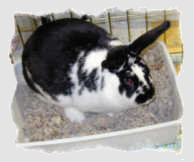
Litter Training Your Bunny
By nature, rabbits choose one or a few places (usually corners) to deposit their urine and most of their pills. Urine-training involves little more than putting a litter-box where the rabbit chooses to go. Pill training requires only that you give them a place they know will not be invaded by others. Here are some suggestions to help you to train your rabbit to use the litterbox.
Age
Older rabbits are easier to train than younger rabbits, especially babies. A rabbit's attention span and knack for learning increases as he grows up. If you have a baby, stick with it! If you are deciding whether to litter train your older rabbit, go for it!
Spaying/Neutering
When rabbits reach the age of 4-6 months, their hormones become active and they usually begin marking their territory. By spaying or neutering your rabbit, he will be much more likely to use his litterbox (as well as be much healthier and happier). Adult rabbits benefit from spaying or neutering during their lives as well. Unspayed females have a 85% chance of developing uterine cancer.
Types of Litter
The House Rabbit Society recommends organic litters made from alfalfa, oat, citrus or paper. (Some brands to look for: Care Fresh, Citrafresh, Yesterday's News, Cat Country, Critter Country) A wonderful and inexpensive litter is wood stove pellets, which can be purchased at home improvement stores or fireplace supply stores. Hay can also be used as litter, but needs to be changed daily as your rabbit will be eating it as well. Stay away from litters made from softwoods, like pine or cedar shavings or chips, as these products are thought to cause liver damage in rabbits who use them. Also avoid clay or clumping cat litters.
Cleaning and Disposal
Clean litterboxes often, to encourage your rabbit to use them. Use diluted white vinegar to rinse boxes out. Accidents outside of the cage can be cleaned up with white vinegar or club soda. If the urine has already dried, you can try products like "Nature's Miracle" to remove the stain and odor. To dispose of organic litters, they can be used as mulch, or can be composted. Rabbit pills can be directly applied to plants as fertilizer.
Pills vs. Urine
All rabbits will drop pills around their cages to mark it as their own. This is not failure to be litter-trained. It is very important for your rabbit to identify the cage as her property so that when she leaves the cage for the bigger world of your house, she will distinguish the family's area from her own and avoid marking it.To encourage this, make the rabbit the king of his cage. Try not to force him in or out of it; coax him. Do not do things to his cage that he doesn't like, or things to him that he doesn't like while he's in the cage.
Running Space
Even if your goal is to let your rabbit have full run of the house, you must start small. Start with a cage and a small running space, and when your rabbit is sufficiently well trained in that space, gradually give her more space. But do so gradually! If you overwhelm her with too much freedom before she's ready, she will forget where her box is and will lose her good habits.
The Method
Start with a box in the cage, and one or more boxes in the rabbit's running space. If she urinates in a corner of the cage not containing the box, move the box to that corner until she gets it right. Don't be concerned if your bunny curls up in his litterbox; this is natural. If you offer several boxes, she may choose one to sleep in & use the others for the bathroom. Once she's using the box in the cage, open her door and allow her into her running space. Watch her go in and out on her own. If she heads to a corner where there's no box, or lifts up her tail in the characteristic fashion, cry "no" in a single, sharp burst of sound. Gently herd her back to her cage and her litterbox, or into one of the boxes in her room. Be careful, however. You don't want to make the cage or the litterbox seem like punishment. A handful of hay in the box makes it a more welcoming place. After she first uses the box, praise her and give her favorite treat. Once she uses the box in her room a couple of times, you're well on your way, as her good habits will be forming. As she gets better trained in her first room, you can increase her space. Don't hurry this process. If the area becomes very big, or includes a second floor, be sure to include more litterboxes, so as not to confuse her. Remember, as she becomes more confident and uses fewer boxes, you can start to remove some of her early, "training" boxes. Get your rabbit into a daily routine and try not to vary it. Rabbits are very habitual and once a routine is established, they usually prefer to stick with it.
Compromise
If your rabbit continually urinates in a spot where there is no litterbox, put his box where he will use it, even if it means rearranging his cage or moving a table in the living room. It is much easier to oblige him than to try to work against a determined bunny! If unbonded rabbits share space, they sometimes mark the area to claim it. You may have to limit the area from the marking bunny.


